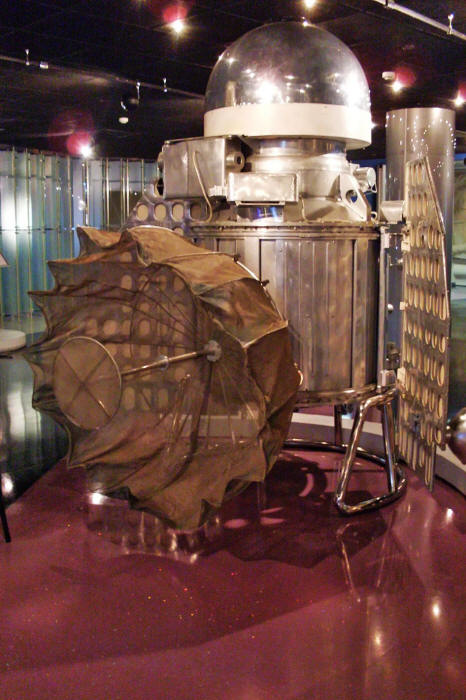|
by Avi Loeb Soviet spacecraft Venera 1 in the Memorial Museum of Cosmonautics.
(Image credit:
Wikimedia)
The decline of the force with distance from the Sun was consistent with the inverse square law characterizing radiation pressure. There was also no evidence for a cometary tail that commonly flags the rocket effect.
'Oumuamua had to lose a tenth of its mass in
order to acquire the observed push.
The mainstream of comet experts disagreed with my interpretation of 'Oumuamua.
They first suggested that 'Oumuamua is a hydrogen iceberg, then a dust bunny, then a nitrogen iceberg and finally a water-hydrogen iceberg, with an invisible coma.
The final attempt to shove 'Oumuamua's anomalies under the carpet of traditional thinking was made by a team of researchers led by Darryl Seligman, who published a paper in December 2024 in the prestigious journal Proceedings of the National Academy of Science (PNAS).
This paper argued that 'Oumuamua is a member of a population of Dark Comets, recently discovered near Earth.
The paper argued that they represent a weak
version of 'Oumuamua, with smaller sizes and weaker
non-gravitational accelerations.
Once Richard sent me the results, I searched archival records of spacecraft launched during the space age following Sputnik 1 in 1957.
Within minutes, I found that one of these objects, 2005 VL1, was at closest approach to Earth in November 1965 when the Venera 2 spacecraft was launched by the Soviet Union to explore the planet Venus.
The observed brightness of 2005 VL1 is indeed consistent with a high reflectance from the full surface of Venera 2 including its solar panels.
As known for Venera 2, the orbit of 2005 VL1 implies that it arrived within a short distance from Venus at around February 1966, a highly improbable coincidence for the orbital phase of a natural comet that was not designed for a close encounter with Venus.
Since the orbital period of Venus is 225 days, the chance of a random encounter of a near-Earth object with the precise orbital phase of Venus on the right date is less than one percent...
2005 VL1's orbital parameters are very similar to the reported values for Venera 2.
Given the area-to-mass ratio of Venera 2,
I calculated that 2005 VL1's non-gravitational acceleration and
negligible transverse acceleration match the values expected from
solar radiation pressure.
The publication of our paper was declined by the editor of PNAS, because shortly after our paper was posted online, two research notes, posted here and here, argued that the small differences between the orbital parameters of 2005 VL1 and Venera 2 imply that they are not the same object.
In response, I wrote a brief research note, in which I explained that the small differences in orbital parameters between these objects could have been caused by gravitational deflection and unrecorded maneuvers during the flyby of Venera 2 near Venus.
I submitted this note for publication in Research Notes of the American Astronomical Society (RNAAS), where the other two notes were immediately accepted for publication.
The RNAAS editor wrote back:
As a result, the only publications regarding the possible association of Dark Comets with the Venera spacecraft are authored by the critics of my note and paper.
The calculations to which the critics responded
were declined from publication.
The paper shows that the probability of six Dark Comets showing an orbital constant that matches the value associated with various Venera spacecraft is 0.0007, making the random coincidence between the two sets of objects highly unlikely.
This conclusion supports my initial conjecture about the association between the two populations, implying that these six Dark Comets might be Venera spacecraft.
The abstract reads:
This gives me hope that scientific progress cannot be hindered by traditional thinking.
As Galileo Galilei stated:
|


